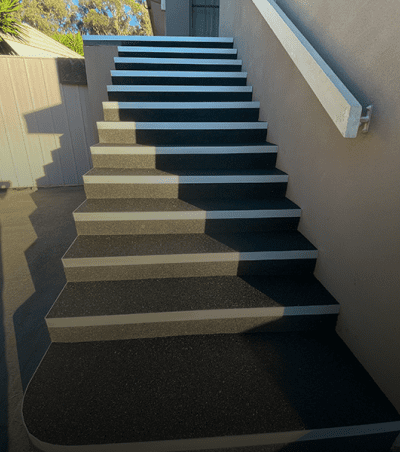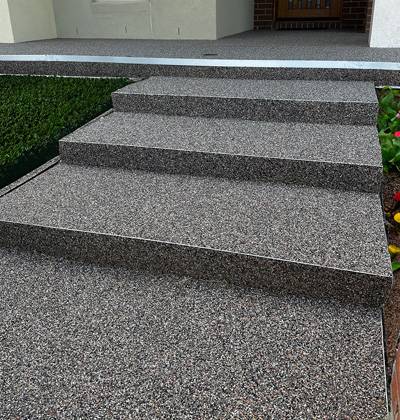Driveway resurfaces pavers represent a transformative approach to enhancing both the aesthetic appeal and functionality of your driveway. These pavers are designed …
Welcome to the elegance, durability, and sustainability world – Natural Stone Carpets. We pride ourselves on being the trusted specialists in natural stone flooring and permeable paving, serving the diverse needs of both businesses and homeowners in Melbourne. With years of experience under our belt, we bring you the perfect solution for permeable, beautiful, and long-lasting flooring. At Natural Stone Carpets, we’re more than just a flooring provider. We are your go-to experts for a range of projects, from swimming pool paving to garage floor resurfacing. Our commitment to using only the highest quality materials, coupled with the expertise of our dedicated installation team, ensures that every project we undertake is completed to your utmost satisfaction.
We cater to both residential and commercial spaces, providing exquisite Natural Stone Designs that not only captivate with their aesthetics but also offer easy maintenance. Each design is customizable, allowing for the creation of something truly exceptional. Our extensive array of styles, finishes, and formats ensures that there’s something to complement every individual’s unique taste.
At Natural Stone Carpets, we aim to offer products that are visually stunning, durable, and tailored to meet the distinct preferences of our clientele.


Permeable Concrete: A Game-Changer in Urban Landscaping.
Learn more

Expert Driveway Resurfacing Services in Melbourne: Restoring Elegance and Durability.
Learn more

Creating Safe and Stunning Pool Paving Surrounds in Melbourne.
Learn more

Elevate Your Alfresco Experience with Melbourne's Finest Paving and Repair.
Learn more

Step Up to Durability and Style with Our Expert Paving Solutions.
Learn more

Crafting Melbourne's Porch Paving Dreams, One Custom Design at a Time.
Learn more
Welcome to the world of elegance, durability, and sustainability – Natural Stone Carpets. We pride ourselves on being the trusted specialists in natural stone flooring and permeable paving, serving the diverse needs of both businesses and homeowners in Melbourne. With years of experience under our belt, we bring you the perfect solution for permeable, beautiful, and long-lasting flooring.
At Natural Stone Carpets, we prioritize accountability and integrity in every aspect of our operations, from design to installation. We ensure ethical sourcing and sustainable practices while delivering on our promises.
Client satisfaction is fundamental to our business. We listen attentively to our clients' needs, providing personalized solutions and attentive service to exceed expectations at every step of the process.
Quality is paramount. From premium materials to meticulous installation, we maintain rigorous standards to guarantee superior results that stand the test of time
Punctuality is key. Our efficient project management and skilled team ensure on-time delivery, minimizing disruptions and maximizing satisfaction for both residential and commercial projects.
Step 01
Provide a free quote estimate by completing our online form
Step 02
Confirm the estimate, and kindly request a final on-site quotation.
Step 03
Approve the quote and select a project start date.


Comfort matters, whether it’s your home or your business. Our floors provide a comfortable surface to walk, stand, and live on. The underfoot sensation is pure bliss, and it’s one of the many reasons our clients love us.
Comfort matters, whether it’s your home or your business. Our floors provide a comfortable surface to walk, stand, and live on. The underfoot sensation is pure bliss, and it’s one of the many reasons our clients love us.
Comfort matters, whether it’s your home or your business. Our floors provide a comfortable surface to walk, stand, and live on. The underfoot sensation is pure bliss, and it’s one of the many reasons our clients love us.
Trustindex verifies that the original source of the review is Google. Called Jeff for a quote, he and his team were out the same day to look at the job. Very reasonable pricing compared to some other quotes I had received. I had NSC do resurfacing of around 150sqm of existing concrete and we couldn’t be happier with the result. The guys are meticulous and worked extremely hard to get the job done on time. Would absolutely recommend NSC to anyone considering their services. 5/5Trustindex verifies that the original source of the review is Google. Natural Stone Carpets team were always polite and professional throughout our driveway replacement. The quality and workmanship was exceptional so I can honestly highly recommend Natural Stone Carpets to anyone considering a driveway repair/replacement or renovation. Well Done!!Trustindex verifies that the original source of the review is Google. I'm very satisfied with the results. The installation was fast and easy, it looks great!Trustindex verifies that the original source of the review is Google. Professional from start to finish. The workmanship is flawless and their attention to detail is second to none. Glad I made the decision to go with these guys than with some of their other quotes I got.Trustindex verifies that the original source of the review is Google. Wow, they did a fantastic job on my outdoor living area. Will book to have my front and side of the house done soon. Very pleased with the outcome.Trustindex verifies that the original source of the review is Google. Natural stone carpets where great from start to finish with their service and end product , glad I chose them as my driveway is looking remarkable and stylish. Highly recommended this to anyone wanting their driveways done.
Driveway resurfaces pavers represent a transformative approach to enhancing both the aesthetic appeal and functionality of your driveway. These pavers are designed …
Everyone loves beauty. We all love beauty. Especially those who do not love natural beauty! People often travel to parks full of …
Permeable paving, also known as porous pavement or pervious pavement, is a type of surface material used in roads, parking lots, sidewalks, …
0412 493 066
contact@naturalstonecarpets.com.au
www.naturalstonecarpets.com.au
Copyright © 2025 Natural Stone Carpets Australia. All Rights Reserved.
Demo Description

This will close in 40 seconds